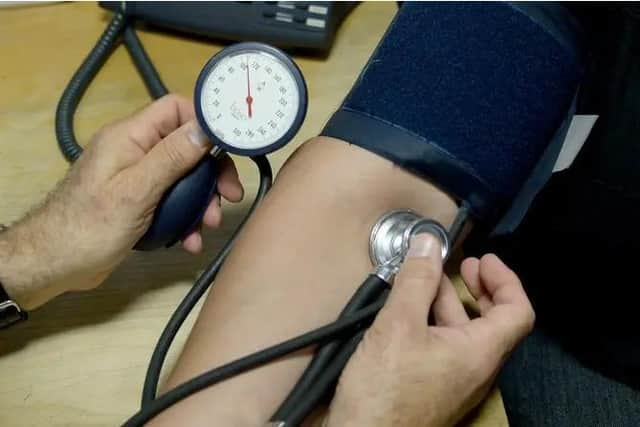NHS crisis: How many doctors, nurses and midwives are there at Mid Yorkshire hospitals?
and live on Freeview channel 276
A recent report from a cross-party group of MPs led by former Health Secretary Jeremy Hunt said the Government must tackle "the greatest workforce crisis in history in the NHS" as it deals with the aftereffects of the coronavirus pandemic.
The study by the Health and Social Care Committee criticised the absence of a long-term plan to address stalling recruitment and persistent short-staffing, adding that the NHS is currently in need of tens of thousands of workers.
Advertisement
Hide AdAdvertisement
Hide AdWe have taken a look at NHS figures for Mid Yorkshire Hospitals Trust to see how the workforce has changed in recent years, as the crisis across the country deepened.


Doctors
The latest figures from NHS Digital show there were the equivalent of 810 full-time doctors as of April at Mid Yorkshire Hospitals NHS Trust.
This was down from 815 last year but up on the 737 in April 2016 – when comparable figures for all professions began – equating to a rise of 10% over the last six years.
Nationally, there were 128,000 FTE doctors in NHS trusts in April, up from 124,000 the year before and 104,000 in 2016.
Advertisement
Hide AdAdvertisement
Hide AdBut the workforce figures, which provide a snapshot overview, do not account for the number of health care workers who joined and left the NHS in between counts, nor do they indicate how staffing levels compare to demand for services.
The report by the Health and Social Care Committee said the NHS must still recruit a further 12,000 hospital doctors to address a current national shortfall.
The British Medical Association called on the Government to publish workforce projections, reduce medicine's gender pay gap and increase the supply of affordable childcare.
Emma Runswick, the BMA deputy chair of council, said: "If the Government continues to ignore this – or continued warnings from reports like this – the impact on health professionals, patients and the very health of our society does not bear thinking about."
Midwives
Advertisement
Hide AdAdvertisement
Hide AdThere are fewer midwives across the country than last year – the figures show there were the equivalent of 21,741 working full-time hours in April, down from 22,374 last year.
It comes as the MPs’ report says 2,000 more midwives are urgently needed to address staffing shortages.
At Mid Yorkshire Hospitals Trust there were 193 midwives in April – down from 217 last year.
The Royal College of Midwives said people are leaving the industry because "morale is shattered".
Advertisement
Hide AdAdvertisement
Hide AdSuzanne Tyler, executive director at the RCM, said: "Employers and the Government must step up, put in the resources, and show they really value their staff."
Nurses and Health Visitors
The figures also show there were 1,709 nurses and health visitors at Mid Yorkshire Hospitals Trust in April.
This is up from 1,629 last year but down from 1,762 at the start of the pandemic.
But the committee said there is a vast shortage of nurses nationally, with the NHS needing to urgently recruit more than 50,000 nurses and midwives.
Advertisement
Hide AdAdvertisement
Hide AdIn England, there were 319,000 FTE nurses and health visitors in April – up from 310,000 the year before and 285,000 in 2016.
The Royal College of Nursing said persistent understaffing "poses a serious risk to staff and patient safety" and urged the Government to take immediate action.
Patricia Marquis, director of the RCN, said the report, which highlighted unacceptable pay for some NHS nurses who are struggling to feed their families and pay their rent, "should make the Government rethink the latest pay deal that follows a decade of real terms pay cuts".
Sickness Rates
Understaffing is not the only issue facing the NHS workforce.
Advertisement
Hide AdAdvertisement
Hide AdDifferent NHS Digital figures show trusts are still grappling with staff sickness, as the absence rate across all roles nationally rose to 6% in March – the fourth highest month since the pandemic began and well above pre-pandemic levels of 4.1% in March 2019.
At Mid Yorkshire Hospitals Trust, 7% of full-time staff days were lost due to sickness absence in March.
In March 2019, the rate stood at 4.4%.
The RCN said that the high absence figures were "yet more evidence of the need for drastic action and investment in the nursing workforce".
Vacancies
NHS vacancies have also increased more in the year to March than any 12-month period since records began in 2018.
Advertisement
Hide AdAdvertisement
Hide AdSeparate data reveals the NHS had 106,000 FTE vacancies at the end of March, up from 76,000 the year prior.
These include almost 39,000 nursing vacancies, over 4,000 more than 12 months ago.
In the North East and Yorkshire, there were 13,257 total vacancies as of 31 March – up from 8,075 a year earlier – including 4,774 for nurses.
What the Government has said
The Department of Health and Social Care said it has commissioned NHS England to develop a long-term workforce plan.
Advertisement
Hide AdAdvertisement
Hide AdA spokesperson said: "We are growing the health and social care workforce, with over 4,000 more doctors, and 9,600 more nurses compared to last year, and over 1,400 more doctors in general practice compared to March 2019.
"As we continue to deliver on our commitment to recruit 50,000 more nurses by 2024, we are also running a £95 million recruitment drive for maternity services."